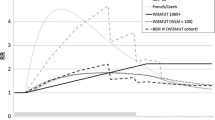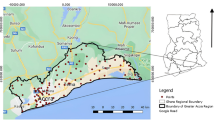Abstract
In the last few decades attention has been given to improve workplace conditions, primarily to reduce the different health risks. In the air that accumulates in underground workplaces radon may constitute one of the health risks. The radon concentration in the show cave in Tapolca is especially high in summer months, with the annual average in the year 2005 being 7227 Bq/m3, in 2006 8591 Bq/m3. The radon concentration was found to be independent on the location of the measurement. Its value was rather similar for working hours and for the total period. The hours spent in the cave by the workers depend on the number of visitors. The radiation dose, estimated on the basis of personal dosimeters, is significant for those working there especially, employed during the whole year. Taking into consideration the actual working hours and the equilibrium factor, F = 0.4, given in the literature, it approaches and even exceeds the dose limit of 20 mSv/year. With a well organized work schedule, as well as the employment of outside workers during the summer period, the dose limit of 20 mSv/year can probably be maintained. However, on the basis of recent measurements, the actual equilibrium factor was determined to be F = 0.5, which in turn means a further 25% increase in the dose effect.
Similar content being viewed by others
References
R. W. Hornung, J. A. Deddens, R. J. Roscoe, Health Phys., 74 (1998) 12.
V. E. Archer, S. D. Wagoner, F. E. Lundin, JOM, 15 (1973) 11.
S. Darby, D. Hill, H. Deo, A. Auvinen, J. M. Barros-Dios, H. Baysson, F. Bochicchio, R. Falk, S. Farchi, A. Figueiras, M. Hakama, I. Heid, N. Hunter, L. Kreienbrock, M. Kreuzer, F. Lagarde, I. Mäkeläinen, C. Muirhead, W. Oberaigner, G. Pershagen, E. Ruosteenoja, A. Schaffrath Rosario, M. Tirmarche, L. Tomásek, E. Whitley, H-E. Wichmann, R. Doll, Scand. J. Work. Environ. Health, 32 (2006) 1.
UNSCEAR, United Nations Scientific Committee on the Effects of Atomic Radiation. Sources and Effects of Ionizing Radiation, Report to the General Assembly, with Scientific Annexes, Vol I: Sources, United Nations, New York, 2000.
ICRP, International Commission on Radiological Protection, Protection Against Radon-222 at Home and at Work, ICRP Publication 65, Pergamon Press, Oxford, 1994.
Hungarian Regulation, 16/2000, Ministry of Health Implementing the Provisions of the Law No. CXVI. of the Year 1996 of Nuclear Energy, Budapest, Hungarian Bulletin No. 55, 2000.
C. R. Cothern, J. E. Smith Jr., Environmental Radon, Environmental Science Research, Plenum Press, New York and London, 1987.
J. Hakl, I. Hunyadi, I. Csige, G. Gécy, K. L. Lénart, A. Várhegyi, Radiat. Meas., 28 (1997) 675.
C. Dueñas, M. C. Fernández, S. Cañete, J. Carretero, E. Liger, Atmos. Environ., 33 (1999) 501.
S. B. Solomon, R. Langroo, J. R. Peggie, R. G. Lyons, J. M. James, Occupational Exposure to Radon in Australian Tourist Caves an Australia-Wide Study of Radon Levels, Yallambie, ISSN 0157-1400, 1996.
I. Kobal, M. Ančik, M. Škofljanec, Radiat. Prot. Dosim., 25 (1988) 207.
J. T. Duffy, J. S. Madden, G. M. Mackin, A. T. McGarry, P. A. Colgan, Environ. Intern., 22 (1996) 415.
K. Balogh, I. Csige, J. Hakl, E. Hertelendi, I. Hunyadi, E. Koltay, Á. Kovách, I. Rajta, Fejezetek a környezetfizikából, Debrecen, KLTE-ATOMKI, 1994 (in Hungarian).
N. Kavasi, J. Somlai, T. Kovacs, C. Nemeth, T. Szabo, Z. Gorjanacz, A. Varhegyi, J. Hakl, Radiat. Meas., 41 (2006) 229.
G. Åkerblom, Swedish Radiation Protection Institute, Radon Legislation and National Guidelines, Stockholm, ISSN 0282-4434, 1999.
Y. Ishimori, J. Environ. Radioact., 93 (2007) 51.
M. S. Field, J. Cave Karst. Stud., 69 (2007) 207.
P. Jovanovic, Environ. Intern., 22 (1996) 429.
W. Zahorowski, S. Whittlestone, J. M. James, J. Radioanal. Nucl. Chem., 236 (1998) 219.
P. Szerbin, Health Phys., 71 (1996) 362.
N. Kavasi, J. Somlai, T. Kovacs, T. Szabo, A. Varhegyi, J. Hakl, Radiat. Prot. Dosim., 106 (2003) 263.
IBSS, International Basic Safety Standards for Protection Against Ionizing Radiation and for the Safety of Radiation Sources, Safety Series No. 115, International Atomic Energy Agency, Vienna, 1996.
Author information
Authors and Affiliations
Corresponding author
Rights and permissions
About this article
Cite this article
Somlai, J., Szeiler, G., Szabó, P. et al. Radiation dose of workers originating from radon in the show Cave of Tapolca, Hungary. J Radioanal Nucl Chem 279, 219–225 (2009). https://doi.org/10.1007/s10967-007-7307-3
Received:
Published:
Issue Date:
DOI: https://doi.org/10.1007/s10967-007-7307-3




